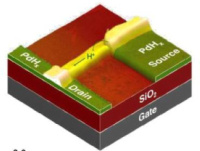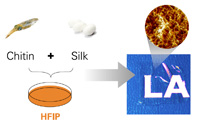Investigating Protonic Conduction in Biological Nanofibers

Nature offers a variety of ready-made nanocomponents for a truly bottom up approach to nanoelectronics, however most biological systems are poor electronic conductors. In this project, we investigate the protonic transport properties of certain hydrated biological fibers, in which protons are able to efficiently transfer along nanoscopic channels of hydrogen bonded water. Potential applications include: biological transistors, protonic interconnects for interfacing bio-based sensors, and environmentally friendly ionic conductors for fuel cells and batteries.
Biomimetic Chitin-Silk Hybrid Nanocomposites

Chitin and silk are naturally abundant biomaterials that are currently under intense studies. Due to their promising materials characteristics such as biocompatibility and biodegradability, both chitin and silk are versatile building blocks for functional material/device systems in a broad spectrum of applications including biomedical fields. Especially, building on each material's characteristics, the hybridization of chitin and silk by Nature's design results in unique synergistic features such as exceptional mechanical properties. Examples include the toughness of Nacre, the hardness of chiton tooth, and the tensile strength of shrimp club.
In this project, we design and tailor biomimetic chitin-silk hybrid systems via a simple solution approach. The chitin-silk hybrid biocomposite is made of ultrafine (3 nm) chitin nanofibers embedded in the silk fibroin matrix. The biocomposite is optically transparent and mechanically strong. With the ease of solution processing, natural abundance of the material constituents, and biodegradability, this chitin-silk biocomposite may find applications in naturally-derived plastics as well as biomedical devices such as microneedles for drug delivery.
Visual Communication in Science

Diagrams and figures are a critical and vital part of scientific communication. They share results, create inspiration, conceptualize ideas, and provide a common ground for discussion, especially in an interdisciplinary collaborations. On the other hand, if poorly constructed, diagrams and illustrations can confuse, mislead and obscure information. We are interested in the role that visual diagrams play in scientific communication, how scientists might be trained to create better diagrams, and how better diagrams can improve communication and collaborations between scientists from different disciplines.
Previous Research
